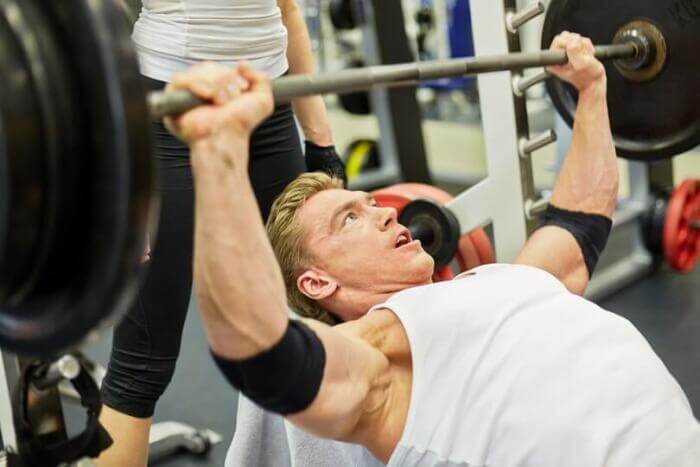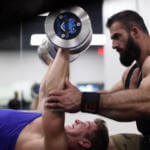Have you made any real progress lately in your bodybuilding, say over the past month or three months? Or even six months? Has your muscular size increased, or have you just increased your body fat? Do you feel your recent training has been worthwhile? Has your training degenerated into an aimless pursuit of a physique that you no longer believe you can achieve and the use of an approach completely devoid of strategy and rationality?
These are some of the equations that many bodybuilders would rather avoid asking themselves. But time rolls on, years slip by, and if you’re not making any progress now, you are unlikely to in the future.
A Good Physique Is The Result of Many Small Gains.
The best physiques are always the result of many small gains over a long period. Progress doesn’t appear miraculously by accident. Training and just hoping for success are no good. What is needed is a cursory look at the fundamentals of muscle growth, a reminder of what it is basically about, and an adoption of a strategy that will give you the best chance of fulfilling your bodybuilding aspirations.
The Fundamentals of Muscle Growth
1. Training
The most fundamental requirement for muscle growth is the use of progressively heavier and heavier exercise poundages while maintaining good exercise form. If you have made little progress in increasing your size, then it is almost certain that you will be using the same or less exercise poundage as you were a few months ago or even years ago.
The idea that you can build bigger muscles without using bigger poundages is a myth. If you want bigger muscles, you must strive to become stronger. If you use little weights, then don’t expect to have anything other than little muscles.
If you would ensure that your training is progressive, then your muscles will increase in size without you hardly giving a thought to the equipment you are using, the food you are eating, your mental attitude, the supplements you are taking, or any other aspect related to bodybuilding. Of course, all of these considerations can play an important role in bodybuilding, but, except for really glaring deficiencies, their importance is very much secondary to progressive resistance training.

Basic, Short, and Intense Exercise Program
To provide the stimulus for increased strength and thus increased muscle size, the exercise program must be fairly short, basic, and intense. Spreading your effort over long routines and too frequent workouts might be alright for bodybuilders who are putting the finishing touches to an otherwise large and fine physique, but it will just not do to provide the stimulus for large and constant muscle growth.
If you would put your all into twice-weekly workouts comprising a maximum of about eight basic exercises to cover all your main muscle groups, you will be doing all that is necessary to stimulate growth. Even this amount of training may be too much for some of you.
The use of very short and radical training programs (as low as three core exercises once a week) is occasionally needed for the extremely weak hard gainer who has next to no potential for building muscle. Such approaches have provided gains when everything else has failed. Only you can decide the exact quantity of work you can tolerate and respond to. As a general rule, do less rather than more but do it harder.
The Three Core Exercises for a growth routine are Squats, Bench Presses, and Bent Over Rows/Pulldowns/Pullups. To try to build size without using these exercises, especially the squat, is to make a very difficult task almost impossible.
Repetitions – How Many?
Repetitions are very much an individual matter, and some experimentation may prove worthwhile. In most cases, 15-20 repetitions are best for squats, calves, and abdominals, and around ten repetitions for other exercises. Except for warm-ups and sub-maximal sets, you really put all you have got into each set and grind out every repetition in good style. No heaving, dropping, or bouncing of the weights. Just stick with ordinary straight sets.
Don’t develop an intense neurosis and become involved in forced repetitions, negatives, compounding, etc. Such an approach is a near sure way to overtrain. Take sufficient rest between sets to ensure you do justice to each one.
Don’t Train Flat Out Every Session
It is a myth that you must train flat out at every session. The body will not tolerate such an approach and will quickly be overtrained. A sub-maximal workout every other week or so, a week’s layoff every couple of months, and occasional periods of several weeks just doing easy sub-maximal work are all necessary for lasting progress.
The idea is to coax your body to greater size and strength by using intensive training rather than trying to build a physique in a mega-intensive couple of months. You should never forget the key phrase is, “progressive resistance.” As the weeks pass by, you must add a few pounds to each of your exercises. A little at a time adds up to huge increases after a year or two, accompanying large increases in muscular size
2. Goals
Only a minute proportion of trainees have the inherited potential to build top-class physiques. Those who have such potential are those who make spectacular progress on almost any routine. They are not typical of bodybuilders and should not be used as examples.
Most of us have minimal bodybuilding potential and must set our ultimate training goals accordingly.
A realistic but outstanding achievement that is attainable for most of us would be, for example, 15-16 inch arms and 44 inches chest on a lean and proportionate physique at around 5’9″ and 160lb. If or when such goals have been achieved, then, and only then, should higher goals be set. Without such realistic goals, you will likely be tempted into using very unrealistic routines, which will not even allow you to achieve very moderate goals.
Together with your ultimate bodybuilding goal, you must keep a training diary and make a written record of your goals for each set of each exercise of each workout and your poundage targets for each training period of a couple of months or so. Keep these repetition and poundage goals realistic and then be prepared to almost die in the effort to achieve them.
3. Attitude and Commitment
A training program can only work if you want it to and are prepared to make the necessary commitment. No one else can do it for you. While performing each repetition, set, and workout (except warm-up sets and sub-maximal workouts), you must become completely selfish. You must put total effort, determination, and concentration into your training. Anything less will bring your bodybuilding progress to a standstill.
A growth routine only has a minimum of work so that you can give everything you have got to it. Muscles do not grow on request; you must demand growth by training very hard and then provide sufficient rest to permit recovery and growth.
You must develop the attitude that is needed to drive you to perform your workouts with the necessary effort and commitment. Effective training though short and infrequent, must be almost brutally hard. Use any imagery to help give you this degree of effort. Each hard set and workout is an opportunity to take you nearer to your ultimate goals, be sure never to waste such opportunities. You must develop the attitude of performing “willpower” repetitions and sets. Nothing less will do.
Outside of your training, it would be best if you fully committed to adopting those good habits necessary for recovery from and response to training. The whole of your living style counts, not just a few single factors. You must eat a well-balanced, sensible, and healthy diet while always avoiding overeating.
Overeating is as counterproductive as overtraining. Only eat sufficiently to allow a slow increase in body weight. Keep a close check on your waist measurement, and never allow yourself to get fat. Get all the sleep and rest that you need. If you have to be woken by an alarm most mornings, you are not getting sufficient sleep.
Keep physical activities to a minimum while specifically training for size and strength. Always maintain a positive attitude, keep images of success in your mind and keep achieving the short-term goals you have set for yourself.
4. Patience and Persistence
It takes time to make noticeable gains in muscular size. But little by little, the small gains and the achievement of small goals will eventually produce significant increases in muscle size. You cannot hurry gains in muscular size by overtraining, overeating, or adding weight to your exercises before you can properly manage it.
Earn each poundage increase by being able to perform your repetition target using the perfect exercise form.
We all want to progress as quickly as possible and are tempted to rush the process. Real visible progress takes months and even years. You need to be patient and continually persist with good habits that will eventually ensure that you attain your goals.
Each small goal achieved is one further step on the pathway to success. Continually drive yourself toward new goals. You know what you want, and you know the strategy by which to get it-persist with it, be patient, and you will get your reward.
5. Avoid BodyBuilding Neurosis
When kept in proportion, bodybuilding is a great activity that can transform your appearance and physical and mental well-being in a relatively short time. But when bodybuilding becomes the be-all and end-all of everything, it can lead to pernicious obsession, unrealistic expectations, and loss of priorities in life.
Drug use and the destruction of health are at the end of this avenue. Yes, bodybuilding is a great activity but always remember that life is more than just bodybuilding. Bodybuilding should be regarded as a very enjoyable way of improving our well-being, life, and contribution to society.
Avoid being dogmatic in your bodybuilding views, and be prepared to be flexible, especially in your training program. It would be best if you had realistic goals together with realistic training practices. We are all individuals and must recognize that what might work for one individual will not necessarily work for another. Some rational experimentation within a general and basic framework is necessary if you are to fulfill your potential.
Only you can know your body and its response to training. You must keep an open mind and recognize that sometimes rather radical training procedures are needed to stimulate growth. If what you are currently using does not work, no matter who recommended it, you have nothing to lose by changing it and trying a more radical approach.
References and Excerpts
Author: Stuart McRoberts. Article: The Essentials of Bodybuilding. Magazine. Muscle Training Illustrated
Author: Adam Cambell. Article: 10 Muscle Building Fundamentals. Website. Menshealth.com
Author: Jacob Wilson. Article: Muscular Hypotrophy: This is How You Grow. Website. BodyBuilding.com










